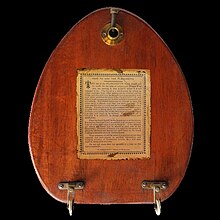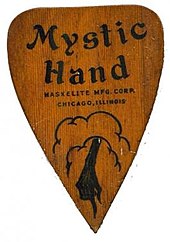Planchette

A planchette (
Planchettes took on a variety of forms during the height of their popularity. American planchettes were traditionally heart- or shield-shaped, but manufacturers produced a wide range of shapes and sizes hoping to distinguish themselves in the highly competitive and profitable market of the devices' late-1860s heyday. Manufacturers espoused the wonders and benefits of different materials (including various hardwoods, India rubber, and even glass), insulated casters, and various attachments meant to "charge" the devices or insulate the user from malevolent spirits.[5] In Great Britain, planchettes took on the classical shapes popularized in early illustrations and newspaper depictions, with round, blunt noses and flat backs. Regardless of their shape or country of origin, almost all planchettes were equipped with brass casters and small wheels of bone or plastic, and their sometimes lavishly illustrated boxes were often packed with blank parchment, pencils, ouija-like folding letter sheets, and esoteric instructions espousing the mysterious communicative powers of the items.[6]
Though planchettes experienced great surges of popularity in Victorian times, in modern usage the term is most commonly associated with the heart-shaped pointers for Ouija or "talking boards". Rather than writing, these devices "dictate" messages by pointing to the board's printed letters and numbers. As writing planchettes were popularized during the beginning of the spiritualist movement of the mid-19th century, planchettes predate the popularization of talking boards by nearly four decades.
History

Planchettes rose to prominence in the years following the establishment of
In the winter of 1852–53, the fervor of the
The use of planchettes in Europe became popular enough to attract the attention of the
Planchettes came to America in 1858 when Spiritualist and social reformer Robert Dale Owen and his friend Dr. H.F. Gardner observed the devices in use at séances in Paris, and returned with several of them. Their friend, the Boston bookseller G.W. Cottrell, became the first to manufacture planchettes on a large scale the following year.[10]
In 1867, the British publication Once a Week published a sensational piece on planchettes. The article was reprinted in European and American newspapers,[12] and by 1868 dozens of booksellers and toy manufacturers were producing the items to meet an insatiable demand on both sides of the Atlantic. Kirby & Co., the undisputed kings of planchette manufacturing, claimed to have sold over 200,000 in their first season alone.[11]
Over the years, planchette manufacturers included such established firms as
Decline and evolution

Following the commercial introduction of the Ouija board by Charles Kennard's Kennard Novelty Company and acquisition of the talking board patent by his partner Elijah Bond on 1 July 1890,[14] automatic-writing planchettes took a secondary role to the suddenly popular Ouija board and the many imitators its success spawned. Though early press articles had dubbed the Ouija the "new planchette," the patentees were initially quick to differentiate their devices from classic automatic writers by pairing them with paddle-shaped, pencil-less pointers far different in shape from other planchettes of the period.[15] The design changes and focus on the elegantly varnished boards and their clearly stenciled letters arching across their fronts seem to have had the intended effect, and the items were enthusiastically welcomed by the public in much the same way planchettes had experienced their own craze some 23 years previously. From this point on, the pencil-equipped planchettes that had facilitated often-garbled spirit writing for nearly four decades were quickly shoved aside in favor of the cleaner, faster communications of these new "talking boards." Though writing planchettes would enjoy brief revivals in subsequent years as the Ouija's popularity similarly waxed and waned, by the 1930s only British toy companies such as Glevum Games continued to produce true writing planchettes in any worthwhile numbers. By the Ouija revival that followed the Second World War, true writing planchettes were no longer being manufactured in any significant numbers anywhere, having been finally completely taken over by the more popular Ouija as they faded into obscurity.[16]
In popular culture

During the initial craze in the late 1860s, planchettes became the subject of several popular songs sold in sheet music form. In 1868, the C.Y. Fonda sheet music company of Cincinnati published the "Planchette Polka", composed by August La Motte, dedicated to Kirby & Co, which was the dominant planchette manufacturer of the day.[17] Also in 1868, the Lee & Walker sheet music company of Philadelphia debuted the song "Planchette" with words by Elmer Ruan Coates and music by Eastburn. The song includes the chorus "Planchette, planchette, oh! Let me see/What luck you have in store for me!"[18] In 1870, Oliver & Ditson sheet music company of Boston published "Planchette: The Celebrated Comic Song" with words by G.A. Meazie Jr, as popularized by the singer Henry Clay Barnabee.[18][19] Barnabee described the song as "named after a little pseudo-psychic machine, a fad of the hour".[20]
The 9 July 1892 Volume 103 edition of Punch included a cartoon depicting an impish devil pushing a planchette toward a prediction of the next Derby winner, claiming the device would "put an end to all speculation."[21]
The 25 March 1907 edition of the
Use of a planchette is featured in the 1948 novel No Highway by Nevil Shute, where the written message obtained by automatic writing provides the information necessary to locate of the tail plane of a crashed aircraft.[23]
In The Haunting of Hill House, a 1959 novel by Shirley Jackson, Mrs. Montague uses a planchette in an attempt to communicate with spirits in Hill House, while Mr. Montague and the original group disagree with her charlatanic methods.[24]
Artist Frederick Sands depicted the planchette in use in his watercolor "La Planchette" in the 1960s.[25]
In August 2012, the
See also
References
- S2CID 145631775.
- ISBN 978-1-84765-295-9.
- JSTOR 26028508.
- ^ Robert Todd Carroll. "Skeptic's Dictionary: Energy". Skepdic.
- ^ "American Planchette Gallery". Retrieved 16 January 2012.
- ^ "British Planchette Gallery". Retrieved 16 January 2012.
- ^ a b Brown, Slater, The Heyday of Spiritualism. New York: Hawthorn Books. 1970.
- ^ Arthur Conan Doyle, The History of Spiritualism Vol I, Arthur Conan Doyle, 1926.
- ISBN 0-85384-043-1
- ^ a b Cottrell, George, Revelations of Planchette], G.W. Cottrell, 1868
- ^ a b Sargent, Epes, Planchette or, The Despair of Science, Roberts Brothers, Boston, 1869
- ^ Once a Week, Once a Week, Vol. 4; Vol. 17, 26 October 1867
- ^ "List of Planchette Manufacturers". Retrieved 16 January 2012.
- ^ "US Trademark Registration Number 0519636 under First Use in Commerce". Tess2.uspto.gov.
- ^ "Museum of Talking Boards". Retrieved 16 January 2012.
- ^ "WilliamFuld.com". Retrieved 16 January 2012.
- ^ "Kirby & Co. at mysteriousplanchette.com". Retrieved 16 January 2012.
- ^ a b Coates (Lyricist), Elmer Ruan (1868). "JScholarship Sheet Music Archives". Retrieved 16 January 2012.
- ^ "134.060 – Planchette. The Celebrated Comic Song". Levy Music Collection. Oliver Ditson & Co., originally. Retrieved 2 August 2021.
- ^ Barnabee, Henry Clay (1913). My Wanderings: Reminiscences of Henry Clay Barnabee; Being an Attempt to Account for His Life, with Some Excuses for His Professional Career. Chapple Publishing Company. p. 250.
When I sang my 'Planchette' song - so named after a little pseudo-psychic machine, a fad of the hour, that was supposed to answer questions - ....
- ^ "Punch, Vol 103". Retrieved 16 January 2012.
- ^ "mysteriousplanchette.com". Retrieved 16 January 2012.
- ISBN 978-0-8044-3276-4.
- ^ Spark Notes: The Haunting of Hill House Chapter 7
- ^ "La Planchette". Retrieved 16 January 2012.
- ^ On the scene at 'RuPaul's Drag Race: Reunited'
- ^ Sharon Needles facebook conversation. Retrieved 2012.05.03.
- ^ Mystic Hand Planchette, Museum of the Macabre. Retrieved 2012.05.03.
- ^ "Video Survey of Exhibit on YouTube". Archived from the original on 22 December 2021. Retrieved 16 January 2012 – via YouTube.
